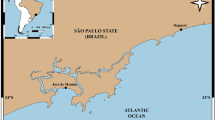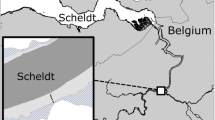Abstract
Rhythmic movements in response to tidal cycles are characteristic of infaunal inhabitant of intertidal soft-bottoms, allowing them to remain in the area with best living conditions. The effect of bioturbators as modifier of local environmental conditions and thus of gradients in intertidal habitats, has not been investigated yet. The Atlantic estuarine intertidal areas are dominated by the burrowing crabChasmagnathus granulatus that generates strong environmental heterogeneity by affecting the physical-chemical characteristics of the sediment. The comparison between intertidal areas with and without crab shows that sediments in the crab beds remain more humid, softer, and homogeneous across the intertidal and along the tidal cycle than areas without crabs. The densities of infauna were higher at high intertidal zones in crab beds than in similar areas without crabs. Infaunal organisms performed vertical movements into the sediment following the tidal cycle that were always of higher magnitude in habitats without crabs. Infaunal species tend to spend most of the time buried into the sediment in the crab bed. Migratory shorebirds use the Atlantic estuarine environments as stopover or wintering sites. They feed (mainly on polychaetes) in the low intertidal zones of both habitats (with and without crabs), but they also feed in the upper intertidal of the crab bed; polychaete per capita mortality rate is higher in the upper part of the crab bed. Environmental heterogeneity produced by crab disturbance has an effect on the infaunal behavior, risk of mortality, and the zonation pattern. This is another example of the ecosystem engineering ability of a burrowing intertidal species.
Similar content being viewed by others
Literature Cited
Alve, E. andJ. M. Bernhard. 1995. Vertical migratory response of benthic foraminifera to controlled oxygen concentrations in an experimental mesocosm.Marine Ecology Progress Series 116:137–151.
Bertness, M. D. 1999. The Ecology of Atlantic Shorelines. Sinauer Associates, Inc., Sunderland, Massachusetts.
Botto, F. andO. Iribarne. 1999. Effect of the burrowing crabChasmagnathus granulata (Dana) on the benthic community of a SW Atlantic coastal lagoon.Journal of Experimental Marine Biology and Ecology 241:263–284.
Botto, F. andO. Iribarne. 2000. Contrasting effects of two burrowing crabs (Chasmagnathus granulata andUca uruguayensis) on sediment composition and transport in estuarine environments.Estuarine, Coastal and Shelf Science 51:141–151.
Botto, F., O. Iribarne, M. M. Martinez, K. Delhey andM. Carrete. 1998. The effect of migratory shorebirds on the benthic species of three southwestern Atlantic Argentinean estuaries.Estuaries 21:700–709.
Botto, F., G. Palomo, O. Iribarne andM. M. Martinez. 2000. The effect of southwestern Atlantic burrowing crabs on habitat use foraging activity of migratory shorebirds.Estuaries 23:208–215.
Brown, A. C. andA. McLachlan. 1990. Ecology of Sandy Shores. Elsevier Science Publishers, Amsterdam, The Netherlands.
Bruschetti, C. M. and O. Iribarne. 2001. Efectos directos e indirectos de cuevas de cangrejos en el comportamiento de forrajeo de aves playeras migratorias. Ira Reunión Binacional de Ecología (Argentina-Chile). April 2001. San Carlos de Bariloche, Argentina.
Chelazzi, G. andM. Vannini. 1988. Behavioral Adaptation to Intertidal Life. Plenum Press, New York.
Conover, W. J. 1980. Practical Nomparametric Statistics. 2nd edition. Wiley, New York.
Coull, B. C. 1992. Ecology of the marine meiofauna, p. 18–38.In R. P. Higgins and H. Thiel (eds.), Introduction to the Study of Meiofauna, Smithsonian Institution Press, Washington, D.C.
Day, R. W. andG. P. Quinn. 1989. Comparison of treatments after analysis of variance in ecology.Ecological Monographs 59:433–463.
Goss-Custard, J. D. 1984. Intake rates and food supply in migrating and wintering shorebirds, p. 233–277.In G. Burger and B. L. Olla (eds.), Shorebirds: Migration and Foraging Behavior, Volume 6, Plenum Press, New York.
Iribarne, O., A. Bortolus, andF. Botto. 1997. Between-habitats differences in burrow characteristics and trophic modes in the south western Atlantic burrowing crabChasmagnathus granulata.Marine Ecology Progress Series 155:132–145.
Jones, C. G., J. M. Lawton, andM. Shachak. 1994. Organisms as ecosystems engineers.Oikos 69:373–386.
Manly, B. F. 1998. Randomization Bootstrap and Monte Carlo Methods in Biology. Chapman and Hall, New York.
Morrison, R. I. G. andR. K. Ross. 1989. Atlas of Neartic shorebirds on the coastal of South America.Canadian Wildlife Service Special Publication 2:131–323.
Mouritsen, K. N. andK. T. Jensen. 1992. Choice a microhabitat in tactile foraging dunlinsCalidris alpina: The importance of sediment penetrability.Marine Ecology Progress Series 85:1–8.
Myers, J. P. andL. P. Myers. 1979. Shorebirds of coastal of Buenos Aires Province, Argentina.Ibis 121:186–200.
Myers, J. P., S. L. Williams, andF. A. Pitelka. 1980. An experimental analysis of prey availability for sanderlings (Aves: Scolopacidae) feeding on sandy beach crustaceans.Canadian Journal of Zoology 58:1564–1574.
Palomo, G. and O. Iribarne. 2001. Crab bioturbation effect and feeding behavior on burrow activity of polychaeteLaeronereis acuta. VII International Polychaete Conference, Reykjavik, Iceland.
Pienkowski, M. W. 1981. How foraging plovers cope with environmental effects on invertebrate behavior and availability, p. 179–192.In N. V. Jones and W. J. Wolff (eds.), Feeding and Survival Strategies of Estuarine Organisms. Plenum Press, New York.
Posey, M. H. 1986. Changes in benthic community associated with dense beds of a burrowing deposit-feeder,Callianassa californiensis.Marine Ecology Progress Series 31:15–22.
Posey, M. H., B. R. Dumbauld, andD. A. Armstrong. 1991. Effects of a burrowing mud shrimp,Upogebia pugettensis (Dana), on abundances of macro-infauna.Journal of Experimental Marine Biology and Ecology 148:283–294.
Quammen, M. L. 1984. Predation by shorebirds, fish and crabs on invertebrates on intertidal mud flats: An experimental test.Ecology 65:529–537.
Rafaelli, D. andS. Hawkins. 1996. Intertidal Ecology. Chapman and Hall, London, U.K.
Reise, K. 1985. Tidal Flat Ecology: An Experimental Approach to Species Interactions. Springer-Verlag, New York.
Rice, W. R. 1989. Analyzing tables of statistical tests.Evolution 43:223–225.
Spivak, E., K. Anger, T. Luppi, C. Bas, andD. Ismael. 1994. Distribution and habitat preferences of two grapsid crab species in Mar Chiquita Coastal Lagoon (Province of Buenos Aires, Argentina).Helgolander Meeresuntersuchungen 48:59–78.
Underwood, A. 1997. Experiments in Ecology. Their Logical Design and Interpretation using Analysis of Variance, Cambridge University Press, Cambridge, U.K.
Wanink, J. H. andL. Zwarts. 1993. Environmental effects on the growth rate of intertidal invertebrates and some implications for foraging waders.Netherlands Journal of Sea Research 31:407–418.
Zar, J. H. 1999. Biostatical Analysis. 4th edition. Prentice Hall, Upper Saddle River, New Jersey.
Zwarts, L. andP. Esselink. 1989. Seasonal trend in burrow depth and tidal variation in feeding activity ofNereis diversicolor.Marine Ecology Progress Series 56:243–254.
Zwarts, L. andJ. H. Wanink. 1991. The macrobenthos fraction accessible to waders may represent marginal prey.Oecologia 87:581–587.
Author information
Authors and Affiliations
Corresponding author
Rights and permissions
About this article
Cite this article
Escapa, M., Iribarne, O. & Navarro, D. Effects of the intertidal burrowing crabChasmagnathus granulatus on infaunal zonation patterns, tidal behavior, and risk of mortality. Estuaries 27, 120–131 (2004). https://doi.org/10.1007/BF02803566
Received:
Revised:
Accepted:
Issue Date:
DOI: https://doi.org/10.1007/BF02803566




